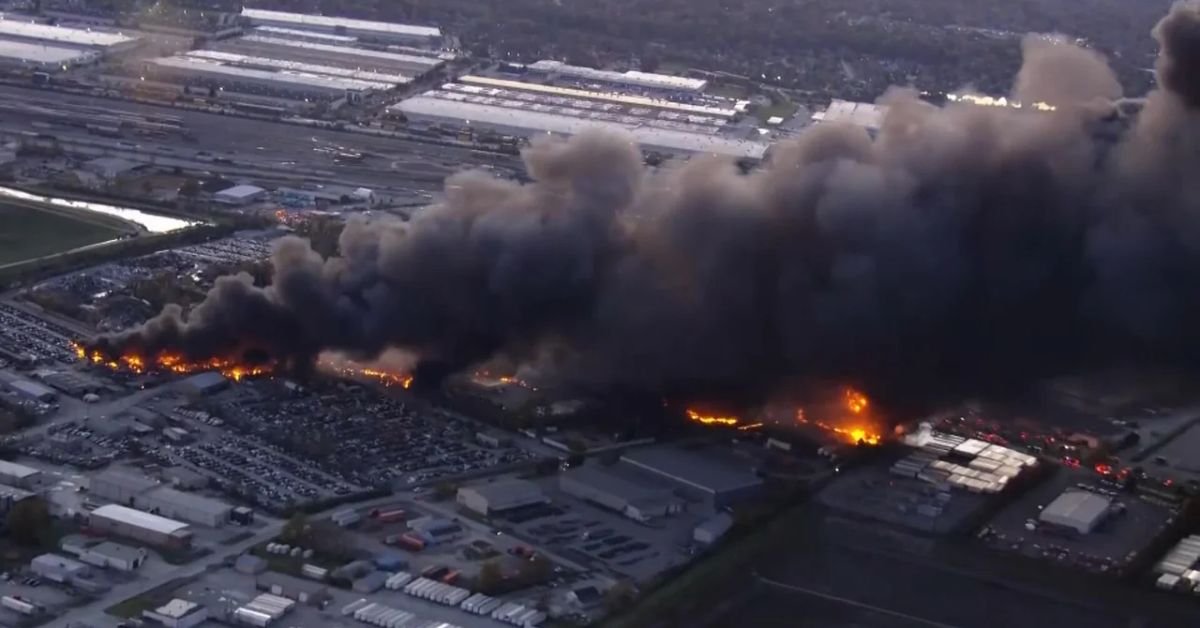Table Of Contents
UPS Plane Crash
As a writer for THOUSIF Inc. – USA, I have always believed that stories like this one resonate deeply, especially when they involve everyday people simply going about their daily lives or doing their jobs.
Yesterday, on November 4, 2025, something unimaginable unfolded in Louisville, Kentucky, a place known for its bustling airport, the heart of UPS operations, and now, tragically, a site of devastation.
I am talking about the crash of UPS Flight 2976, a massive cargo plane that turned a routine takeoff into a nightmare of fire, smoke, and loss.
If you have been searching for answers on terms like “plane crash,” “UPS plane,” “Louisville airport,” or “Kentucky plane crash,” you are not alone.
People across the country are piecing this together, and I am here to walk you through it all, drawing from the whirlwind of reports and eyewitness accounts that have emerged overnight.
Let me start by painting the picture: It is a crisp fall evening in Louisville, KY, around 5:15 p.m. local time.
The sun is dipping low, and at the Muhammad Ali International Airport, often simply referred to as SDF Airport, the massive UPS Worldport hub is humming as usual.
This is not your typical passenger airport; it is the nerve center for UPS, handling hundreds of flights daily and sorting millions of packages.
UPS Flight 2976, a McDonnell Douglas MD-11 (or MD-11F, the freighter version), is loaded up and ready to head west to Honolulu, Hawaii.
With three crew members on board and tanks brimming with about 38,000 gallons of fuel, that is over 230,000 pounds of jet fuel for the long haul, the plane taxies down Runway 17 Right and lifts off.
However, something goes horribly wrong. According to flight data from sources like Flightradar24, the plane climbs to just about 175 feet, hits a speed of around 184 knots, and then it plummets.
Witnesses describe a sharp descent, followed by a catastrophic impact in an industrial area just beyond the runway.
The plane slams into buildings, including what appears to be an auto parts facility and fuel storage tanks, igniting a massive fireball that lights up the sky like a scene from a disaster movie.
Black smoke billows high, visible for miles, and explosions rock the ground as the fuel ignites.
It is chaos, firefighters battling flames hundreds of feet tall, emergency sirens wailing, and a community suddenly thrust into fear.
Now, let us break this down step by step, because when tragedies like this hit, it is easy to get lost in the details.
The Plane: A Closer Look At The MD-11 And UPS Flight 2976
First off, what exactly is an MD-11?
If you are not an aviation buff, think of it as a workhorse of the skies.
Built by McDonnell Douglas in 1991, this particular MD-11 was 34 years old at the time of its retirement.
The MD-11 is a three-engine wide-body jet designed for long-haul cargo flights.
It features a distinctive tri-jet setup, with engines located under the wings and one at the tail, making it reliable for carrying heavy loads over vast distances.
UPS has a fleet of these, and they are a staple at its Louisville hub.
Flight 2976 was no exception.
Registered as N259UP, it was a cargo-only plane, no passengers, just the three crew members handling the controls and navigation.
They were seasoned pros, part of the UPS family that keeps our packages moving overnight.
The flight was bound for Daniel K. Inouye International Airport in Honolulu, a route that demands precision and power.
However, why did it crash? Investigations are just getting started; the National Transportation Safety Board (NTSB) and the Federal Aviation Administration (FAA) are currently involved.
However, early whispers suggest possible mechanical issues, such as an engine failure leading to the sudden drop.
No official cause has been determined yet, but we will continue to monitor the situation for updates.
To give you a quick snapshot, here is a table on the plane’s specs:
| Aspect | Details |
|---|---|
| Model | McDonnell Douglas MD-11F (Freighter) |
| Age | 34 years (Manufactured in 1991) |
| Engines | Three (Two under wings, one in tail) |
| Fuel Capacity | Approximately 38,000 gallons |
| Max Takeoff Weight | Around 630,500 pounds |
| Typical Use | Long-haul cargo, e.g., Louisville to Hawaii |
| Operator | UPS Airlines |
This table highlights why the crash was so explosive; the fuel load alone turned the site into an inferno.
The Crash Site: Louisville Muhammad Ali International Airport And Surrounding Chaos
Louisville’s airport, renamed in honor of the boxing legend Muhammad Ali, is more than just a travel hub; it is UPS’s “Worldport,” a 5.2-million-square-foot facility that processes over 400,000 packages per hour.
Employing thousands, it is the economic heartbeat of Louisville, KY.
The crash happened just off the airport grounds, in an industrial zone near Fern Valley and Grade Lane.
The plane clipped buildings, sparking fires in fuel recycling storage and bulk tanks, which made firefighting a nightmare.
Eyewitnesses? Plenty.
Videos circulating show the plane’s descent, the impact, and the ensuing blaze.
One clip from a nearby camera captures the fireball erupting like a volcano, with debris scattering in all directions.
Louisville Fire Chief Brian O’Neill described the scene as “catastrophic,” with flames challenging even the most experienced crews.
The area affected? About a city block, including auto parts warehouses and fuel facilities.
In response, authorities issued a shelter-in-place order for a five-mile radius around the airport.
Why?
Smoke, potential toxins from burning jet fuel, and the risk of further explosions.
Residents in Louisville, KY, were told to stay indoors, close windows, and avoid the area.
This was not just a precaution; it was necessary amid the thick plume of black smoke wafting over the city.
Here is a timeline table to map out the events:
| Time (Local) | Description |
|---|---|
| ~5:14 PM | UPS Flight 2976 takes off from Runway 17 Right at SDF Airport |
| ~5:15 PM | Plane reaches 175 feet, then descends sharply |
| Immediate After | Crash into industrial buildings; massive fireball and explosions |
| 5:20 PM onward | Emergency responders arrive; fire suppression begins |
| Evening | Shelter-in-place issued for 5-mile radius; airport closes |
| Night | Death toll confirmed at 7; investigations start |
| Next Morning (Nov 5) | Airport reopens; schools closed for safety checks |
This structure helps see how quickly things escalated.
Casualties And Heroic Emergency Response
The human toll is what breaks your heart.
At least seven people lost their lives: the three crew members on the plane, all unaccounted for initially but confirmed deceased, and four on the ground from the impacted buildings.
Eleven others were injured, some seriously, and rushed to hospitals.
Kentucky Governor Andy Beshear, in a somber statement, shared his prayers for the Louisville community and the flight crew, warning that the number of casualties might rise as rescuers comb through the wreckage.
“Let us pray that the number of Kentuckians we have lost stays as low as possible,” he said, his voice heavy with the weight of it all.
Louisville Mayor Craig Greenberg called it an “incredible tragedy our community will never forget.”
Multiple agencies, including the Louisville Metro Police, fire departments, and even federal teams, swarmed the site.
Firefighters battled the blaze for hours, dealing with the added hazard of burning fuel.
The Louisville Fire Department noted the challenges from the site’s industrial contents, but their quick action likely saved more lives.
For resources, officials pointed folks to louisvilleky.gov services for reporting debris or getting help.
Moreover, in a ripple effect, Jefferson County Public Schools (JCPS) closed all classes on November 5 for safety checks on air and water quality.
No one wants kids exposed to any lingering hazards.
Table of key impacts:
| Category | Details |
|---|---|
| Fatalities | 7 (3 crew, 4 ground) |
| Injuries | 11 (Transported to hospitals) |
| Response Agencies | Louisville Fire, Metro Police, NTSB, FAA |
| Community Measures | Shelter-in-place (5 miles), JCPS closures |
| Economic Hit | UPS Worldport halts overnight sorting |
Official Statements And News Coverage
News outlets were on the scene quickly. WLKY, WHAS11, WDRB, and WAVE 3 News provided live chopper footage, showing the smoke and flames in real-time.
WLKY’s aerial views captured the extent of the fire, while WHAS11 interviewed locals shaken by the explosions.
It is that local coverage that really brings the story home.
UPS issued a statement expressing deep sadness: “We are terribly saddened by the accident tonight in Louisville. Our heartfelt thoughts are with everyone involved.”
They committed to safety and supporting the investigation, noting that Louisville is home to thousands of their employees.
Governor Beshear and Senator Mitch McConnell both weighed in, offering condolences and thanks to first responders.
Beshear, in particular, emphasized the importance of prayer and unity in the state of Kentucky.
Broader Context: Aviation Safety And Past Incidents
This is not the first UPS crash. Remember Flight 1354 in 2013, an Airbus A300 that went down in Birmingham, Alabama?
Or the 2010 Dubai incident with Flight 6?
These remind us that while flying is generally safe, cargo operations have unique risks, including heavy loads, night flights, and mechanical wear on older planes, such as the MD-11.
The MD-11 has a mixed history, efficient but with some handling quirks in certain conditions.
As a major player, UPS invests heavily in maintenance; however, age is a factor.
This event is likely to spark discussions on fleet modernization and safety protocols at hubs like Louisville.
Trivia Time: Did you know the Louisville airport was renamed for Muhammad Ali in 2019? The boxing great, born in the city, symbolizes resilience, fitting for a community bouncing back from this.
Community And Long-Term Effects
Louisville, KY, is a tough city, home to the Kentucky Derby, bourbon trails, and now rallying around the families of victims.
Support funds are popping up, and the city promises coordinated aid under the Family Disaster Assistance Act.
Economically, UPS Louisville employs over 20,000; a brief shutdown has ripple effects throughout the region.
However, the airport reopened by morning, demonstrating its resilience.
As we conclude, this tragedy highlights the fragility of life.
From the “plane crash today” searches to worries about “fire in Louisville,” it is a wake-up call.
THOUSIF Inc. – USA stands with Kentucky.
Stay safe, and hug your loved ones.
Thanks for reading this deep dive.
If you are hooked, check out our other posts.
What is your take?
Please share your thoughts in the comments; we are all in this together.






